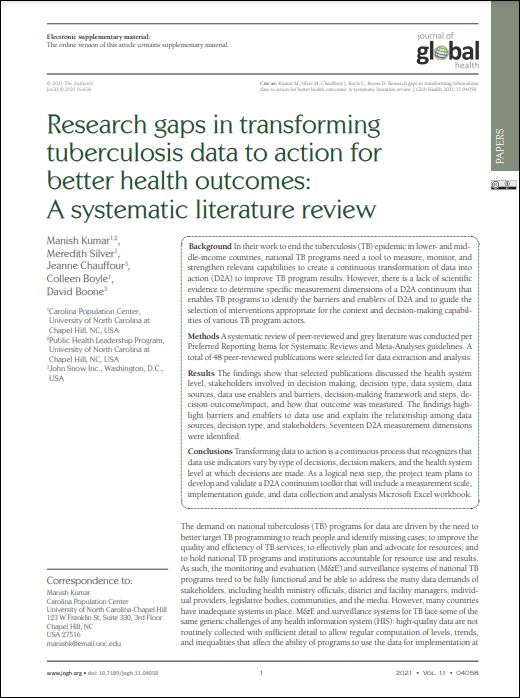Research gaps in transforming tuberculosis data to action for better health outcomes: A systematic literature review

Citation: Kumar M, Silver M, Chauffour J, Boyle C, Boone D: Research gaps in transforming tuberculosis data to action for better health outcomes: A systematic literature review. J Glob Health 2021;11:04058.
Abstract: Background: In their work to end the tuberculosis (TB) epidemic in lower- and middle-income countries, national TB programs need a tool to measure, monitor, and strengthen relevant capabilities to create a continuous transformation of data into action (D2A) to improve TB program results. However, there is a lack of scientific evidence to determine specific measurement dimensions of a D2A continuum that enables TB programs to identify the barriers and enablers of D2A and to guide the selection of interventions appropriate for the context and decision-making capabilities of various TB program actors.
Methods: A systematic review of peer-reviewed and grey literature was conducted per Preferred Reporting Items for Systematic Reviews and Meta-Analyses guidelines. A total of 48 peer-reviewed publications were selected for data extraction and analysis.
Results: The findings show that selected publications discussed the health system level, stakeholders involved in decision making, decision type, data system, data sources, data use enablers and barriers, decision-making framework and steps, decision outcome/impact, and how that outcome was measured. The findings highlight barriers and enablers to data use and explain the relationship among data sources, decision type, and stakeholders. Seventeen D2A measurement dimensions were identified.
Conclusions: Transforming data to action is a continuous process that recognizes that data use indicators vary by type of decisions, decision makers, and the health system level at which decisions are made. As a logical next step, the project team plans to develop and validate a D2A continuum toolkit that will include a measurement scale, implementation guide, and data collection and analysis Microsoft Excel workbook.
Methods: A systematic review of peer-reviewed and grey literature was conducted per Preferred Reporting Items for Systematic Reviews and Meta-Analyses guidelines. A total of 48 peer-reviewed publications were selected for data extraction and analysis.
Results: The findings show that selected publications discussed the health system level, stakeholders involved in decision making, decision type, data system, data sources, data use enablers and barriers, decision-making framework and steps, decision outcome/impact, and how that outcome was measured. The findings highlight barriers and enablers to data use and explain the relationship among data sources, decision type, and stakeholders. Seventeen D2A measurement dimensions were identified.
Conclusions: Transforming data to action is a continuous process that recognizes that data use indicators vary by type of decisions, decision makers, and the health system level at which decisions are made. As a logical next step, the project team plans to develop and validate a D2A continuum toolkit that will include a measurement scale, implementation guide, and data collection and analysis Microsoft Excel workbook.
Shortname: ja-21-289-tb
Author(s): Manish Kumar, Meredith Silver, Jeanne Chauffour, Colleen Boyle, David Boone
Year: 2021
Language: English
Resource Type: Journal Articles
Source: Other
Filed under: D2A, data to action, Journal Article, Literature review, NTPs, Research, TB data, TB programs
